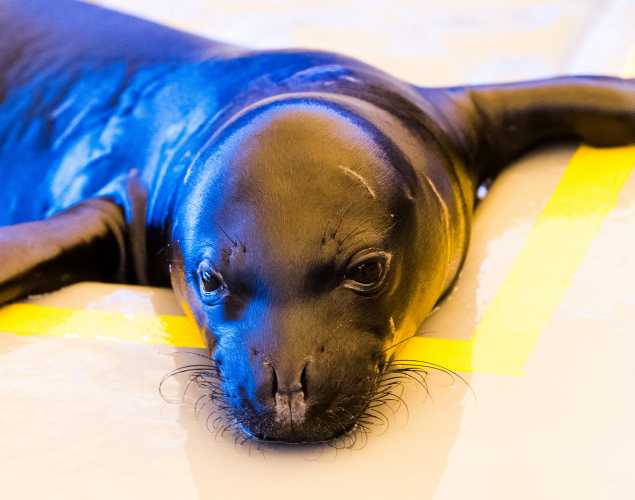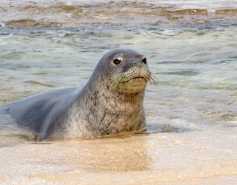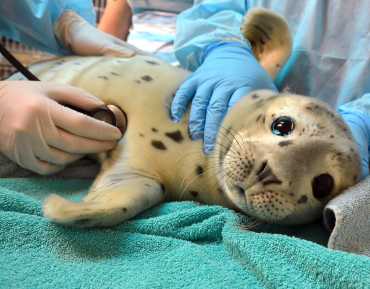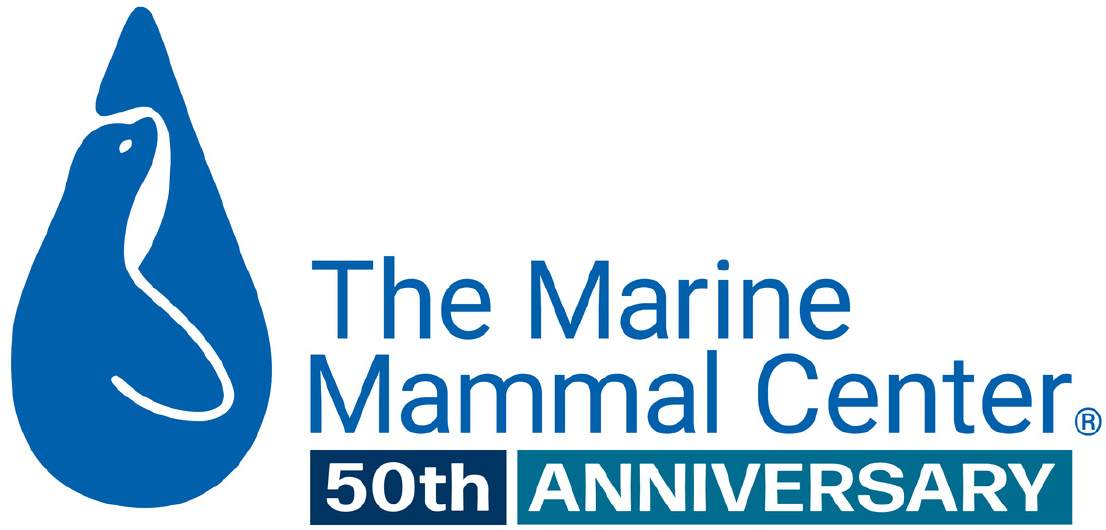
Ke Kai Ola Welcomes Endangered Monk Seal Pup Rescued on Kaua‘i
- Species conservation
Left malnourished after a shortened nursing period, a male monk seal pup was transported from Kaua‘i to our Hawaiian monk seal hospital on Hawai‘i before severe weather was due to hit the islands.
On July 16, Hawaiian monk seal Rocky—known for famously giving birth on Waikiki last year—gave birth once again, but this time on a remote beach on Kaua‘i. The male pup, referred to as RK58 (out of respect for cultural traditions on Kaua‘i, monk seals born there are not named), was involved in a mom-pup pair switch while nursing.
Researchers attempted to reunite Rocky and RK58 multiple times, but the final attempt ultimately proved to be unsuccessful. Given that a hurricane was quickly approaching the islands, which would make air transportation impossible, experts decided to rescue the pup.
You may recall another recent mom-pup pair switch involving Hawaiian monk seal pup Sole, who is currently in our care at Ke Kai Ola.
“While surprising to see a second mom-pup switch on the Main Hawaiian Islands, The Marine Mammal Center is prepared to provide rehabilitative care to any Hawaiian monk seal in need,” says Dr. Claire Simeone, the Center’s Hospital Director at Ke Kai Ola.
Each individual animal’s survival is critical to support the recovery of the population, and we are grateful to give RK58 a second chance at life.
Mom-pup pair switches are a natural event observed each year in the Northwestern Hawaiian Islands, but they are less common on the Main Hawaiian Islands since there is a smaller population of mothers and pups present. This mom-pup pair switch involving Rocky and RK58 is only the second to be observed on the Main Hawaiian Islands—the first being Sole and his mom.
Learn More About Hawaiian Monk Seals
Sign up to receive Hawaiian monk seal news, patient updates and more straight to your inbox.
{"image":"\/Animals\/Wild\/Hawaiian monk seal\/hawaiian-monk-seal-shutterstock.jpg","alt":"Hawaiian monk seal at the shoreline","label":"Pinnipeds","title":"Hawaiian Monk Seal","link_url":"\/animal-care\/learn-about-marine-mammals\/pinnipeds\/hawaiian-monk-seal","type":"page"}

{"image":"\/Animals\/Wild\/Hawaiian monk seal\/cropped-images\/HMS-wild-NOAA-4-832-3197-1474-1603733454.jpg","alt":"Two Hawaiian monk seals sleeping on the beach.","label":"Conservation","title":"Hawaiian Monk Seal Conservation","link_url":"\/science-conservation\/conservation\/hawaiian-monk-seal-conservation","type":"page"}

{"image":"\/Animals\/Patients\/Hawaiian monk seals\/2015\/hms-pearl-by-julie-steelman-c-the-marine-mammal-center-noaa-permit-18786.jpg","alt":"Hawaiian monk seal Pearl","title":"Understanding Endangered","link_url":"https:\/\/www.marinemammalcenter.org\/publications\/understanding-endangered","label":"Online Learning Resource","type":"publication"}

{"image":"\/Animals\/Patients\/Hawaiian monk seals\/2016\/hms-nihoole-5-photo-c-noaa-permit-16632.jpg","alt":"Hawaiian monk seal Niho'ole","title":"Aloha \u02bb\u0100ina","link_url":"https:\/\/www.marinemammalcenter.org\/publications\/aloha-aina","label":"Online Learning Resource","type":"publication"}

Rocky gave birth to RK58 on a Kaua‘i beach near two other mom-pup pairs. The animals were observed daily by trained biologists and volunteers with the National Oceanic and Atmospheric Administration and the Hawai‘i Department of Land and Natural Resources. At about five days old, volunteers saw RK58 switch mothers with another pup. The two pups were reunited with their birth mothers without complication.
But later, RK58 switched mothers again! Researchers were concerned that RK58 would have a shortened nursing time if he stayed with the other mother. Responders did everything they could to keep Rocky and her pup together, but reunification was not successful. RK58 was left without his mother after having nursed for only 19 days, about half the typical nursing period of 35 to 50 days. Intervention was critical for this pup’s survival, especially with severe weather conditions on the horizon.
“This is an unfortunate but natural occurrence that we do see in the wild,” says Jessie Bohlander, Research Marine Biologist and Acting Program Lead for NOAA Pacific Islands Fisheries Science Center’s Hawaiian Monk Seal Research Program. “We are lucky to have a great partnership between NOAA, the Hawaiʻi Department of Land and Natural Resources, The Marine Mammal Center and others to quickly handle these situations, and are hopeful that RK58 will do well at Ke Kai Ola and be successfully released back to the wild.”
Just as in Sole’s case, the United States Coast Guard provided a flight for Dr. Simeone from Honolulu to Kaua‘i, and then on to the Big Island so that RK58 could be safely transported to Ke Kai Ola. Dr. Simeone accompanied the monk seal pup throughout his journey (he slept most of the way!) and is providing supportive care at the hospital with the assistance of staff and volunteers.
During his initial exam, Dr. Simeone determined RK58 was malnourished but otherwise stable. He is receiving nutrition in the form of electrolyte tube feedings, and as he grows stronger he will transition to eating whole fish.
Until veterinarians can confirm RK58 is free from infectious diseases, he and Sole are being kept separate. We are certain Sole will enjoy having a pen-mate in a few days; the two monk seals can be occasionally heard calling to each other! Sole continues to progress during rehabilitation as he makes his transition from tube feedings to free feeding on whole fish.
Human interaction will be kept at a minimum to ensure the pups stay wild. Once each monk seal reaches a healthy body weight and is able to catch fish on his own, the two pups will be released back into the wild with a second chance at life.
It is rare to rescue a monk seal from the Main Hawaiian Islands, and this young pup is only the third from the main islands that we have rehabilitated. Ke Kai Ola, our facility dedicated to endangered Hawaiian monk seals, has rehabilitated 23 monk seals since opening in 2014.
The Center is proud to partner with NOAA to support conservation efforts for the Hawaiian monk seal.
Researchers estimate the current monk seal population to be about 1,400 animals, and about 30 percent of those monk seals are alive today directly due to conservation efforts led by NOAA and its partners.
Due to the Hawaiian monk seal population’s fragile state, members of the public should keep a safe distance from monk seals and report sightings on the Hawaiian Islands to the Center’s response team at our hotline: 808-987-0765.
Header image: Photo by Sheila Latta © The Marine Mammal Center / NOAA permit #18786
Yes, I want to save a life!

Yes, I want to save a life!
You’ll be giving sick and injured animals the best possible care at the Center’s state-of-the-art hospital. With your gift today, you are giving a patient a second chance at life in the wild.
See Our Latest News
{"image":"\/Animals\/Patients\/Hawaiian monk seals\/2025\/cropped-images\/d-ru28release-exam-at-ke-kai-ola111025photo-by-giancarlo-rulli-c-the-marine-mammal-center-noaa-permit-24359-0-0-1270-992-1764620886.jpg","alt":"","title":"Bird Flu Vaccine Trial Offers Hope for Protecting Hawaiian Monk Seals","link_url":"https:\/\/www.marinemammalcenter.org\/news\/bird-flu-vaccine-trial-may-offer-hope-for-protecting-hawaiian-monk-seals","label":"News Update","date":"2025-12-01 08:13:00"}

Bird Flu Vaccine Trial Offers Hope for Protecting Hawaiian Monk Seals
December 1, 2025
Read More{"image":"\/Animals\/Patients\/Hawaiian monk seals\/2021\/hms-pp08-by-sheila-latta-c-the-marine-mammal-center-noaa-permit-18786.jpg","alt":"Hawaiian monk seal","title":"The New York Times: Inside the Bird-Flu Vaccine Trial for Monk Seals","link_url":"https:\/\/www.marinemammalcenter.org\/news\/the-new-york-times-inside-the-bird-flu-vaccine-trial-for-monk-seals","label":"In the News","date":"2025-12-01 01:00:00"}

The New York Times: Inside the Bird-Flu Vaccine Trial for Monk Seals
December 1, 2025
Read More{"image":"\/Animals\/Wild\/Sea otter\/so-wild-morro-bayphoto-c-brian-simuro-20.jpeg","alt":"Sea otter and pup","title":"Watch a Sea Otter Pup Reunite With Its Mother","link_url":"https:\/\/www.marinemammalcenter.org\/news\/watch-sea-otter-pup-reunite-with-its-mother","label":"News Update","date":"2025-11-14 10:35:41"}

{"image":"\/Animals\/Wild\/Sea otter\/sea-otter-photo-c-brian-simuro.jpeg","alt":"Sea otter","title":"AP News: Baby sea otter is reunited with mother in central California after dramatic rescue","link_url":"https:\/\/www.marinemammalcenter.org\/news\/ap-news-baby-sea-otter-is-reunited-with-mother-in-central-california-after-dramatic-rescue","label":"In the News","date":"2025-11-14 09:46:34"}

AP News: Baby sea otter is reunited with mother in central California after dramatic rescue
November 14, 2025
Read MoreHawaiian Monk Seal
